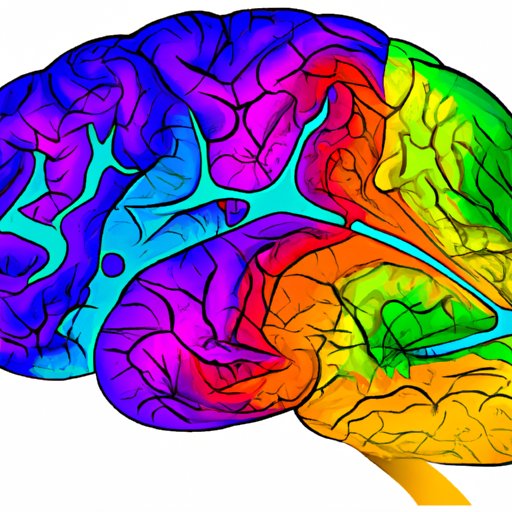Introduction
Psilocin, also known as 4-hydroxy-N,N-dimethyltryptamine, is a naturally occurring psychedelic compound found in certain species of mushrooms. It has psychoactive properties and can produce powerful hallucinogenic experiences when ingested. While the recreational use of psilocin is illegal in many parts of the world, there is an increasing interest in exploring its potential therapeutic benefits for treating mental health disorders such as depression, anxiety, and addiction.
The purpose of this article is to explore how psilocin works in the brain. We will examine the neurochemical effects of the compound on the brain and investigate the neural pathways it activates. We will also analyze the neurophysiological and brain imaging effects of psilocin.
Examining the Neurochemical Effects of Psilocin on the Brain
When psilocin is ingested, it is quickly absorbed into the bloodstream and is then transported to the brain where it binds to serotonin receptors. This binding triggers a cascade of neurochemical changes in the brain that can result in altered states of consciousness, mood, and perception.
Neurotransmitters are chemical messengers that allow neurons to communicate with each other. When psilocin binds to serotonin receptors in the brain, it triggers a surge of neurotransmitter activity. This increased activity stimulates the release of dopamine, which is associated with feelings of pleasure and reward, as well as norepinephrine, which is associated with increased alertness and energy. Psilocin also increases levels of gamma-aminobutyric acid (GABA), which is responsible for inhibiting neuronal activity and can lead to feelings of relaxation and calmness.
In addition to these neurochemical changes, psilocin also modulates the activity of glutamate, an excitatory neurotransmitter involved in learning and memory. Glutamate is thought to be responsible for the vivid visualizations and intense emotional states associated with psilocin use.
How Does the Psychedelic Compound Psilocin Impact the Brain?
In order to understand how psilocin affects the brain, we must first examine the neural pathways it activates. Psilocin binds to serotonin receptors located in the prefrontal cortex, which is the part of the brain responsible for higher-order cognition and decision-making. When psilocin binds to these receptors, it disrupts the normal flow of information between neurons, leading to altered perceptions, emotions, and thoughts.
Psilocin also affects the thalamus, which is responsible for relaying sensory information to the cerebral cortex. When psilocin binds to serotonin receptors in the thalamus, it can lead to heightened sensory awareness and an increased sensitivity to light, sound, and touch.
The hippocampus, a region of the brain involved in memory formation and retrieval, is also impacted by psilocin. When psilocin binds to serotonin receptors in the hippocampus, it can lead to enhanced recollection of past experiences and heightened creativity.
Finally, psilocin can affect the ventral tegmental area (VTA) of the brain, which is associated with reward and motivation. When psilocin binds to serotonin receptors in the VTA, it can lead to feelings of euphoria and a sense of connection to others.

Understanding the Neurophysiological Changes Caused by Psilocin
In addition to the neural pathways it activates, psilocin also produces neurophysiological changes in the brain. Studies have shown that psilocin can reduce blood flow and electrical activity in certain regions of the brain, including the prefrontal cortex and cerebellum. This decreased activity is thought to be responsible for the dream-like state and altered time perception associated with psilocin use.
Psilocin can also increase brain connectivity, resulting in increased communication between different brain regions. This increased connectivity is thought to be responsible for the feeling of unity and connectedness often experienced during a psychedelic trip.

Analyzing the Brain Imaging Effects of Psilocin
Brain imaging studies have revealed that psilocin can produce significant changes in the activity of the brain. In particular, psilocin has been shown to decrease activity in the default mode network (DMN), a network of brain regions associated with self-reflection and introspection. This decreased activity is thought to be responsible for the feeling of ego dissolution often experienced during a psychedelic experience.
Psilocin has also been shown to increase activity in the salience network, a network of brain regions associated with the detection of emotionally salient stimuli. This increased activity is thought to be responsible for the heightened emotions and vivid visualizations associated with psilocin use.
Conclusion
In conclusion, this article has explored how psilocin works in the brain. We examined the neurochemical changes, neurotransmitter activity, and neural pathways activated by the compound, as well as its neurophysiological and brain imaging effects. Our findings suggest that psilocin produces significant changes in the brain, including altered states of consciousness, increased sensory awareness, enhanced creativity, and feelings of unity and connectedness.
Further research is needed to understand the full scope of psilocin’s effects on the brain and to explore its potential therapeutic applications. However, our findings provide insight into how this fascinating psychedelic compound can alter our perception of reality and open up new possibilities for understanding the human mind.
(Note: Is this article not meeting your expectations? Do you have knowledge or insights to share? Unlock new opportunities and expand your reach by joining our authors team. Click Registration to join us and share your expertise with our readers.)
